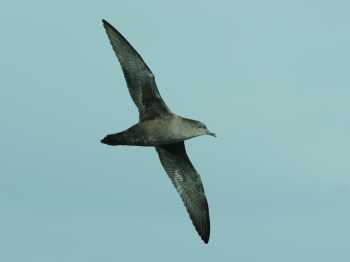April Hedd (Cognitive and Behavioural Ecology Program, Psychology Department., Memorial University, Newfoundland, Canada) and colleagues, writing in the journal Marine Ecology Progress Series, have used geolocators to follow the trans-equatorial migration of Sooty Shearwaters Puffinus griseus in the Atlantic Ocean.
The paper's abstract follows:
"The distributions of many marine birds, particularly those that are highly pelagic, remain poorly known outside the breeding period. Here we use geolocator-immersion loggers to study trans-equatorial migration, activity patterns and habitat use of sooty shearwaters Puffinus griseus from Kidney Island, Falkland Islands, during the 2008 and 2009 nonbreeding seasons. Between mid March and mid April, adults commenced a ~3 wk, >15000 km northward migration. Most birds (72%) staged in the northwest Atlantic from late April to early June in deep, warm and relatively productive waters west of the Mid-Atlantic Ridge (~43-55°N, ~32-43°W) in what we speculate is an important moulting area. Primary feathers grown during the moult had average δ15N and δ13C values of 13.4 ± 1.8‰ and -18.9 ± 0.5‰, respectively. Shearwaters moved into shallow, warm continental shelf waters of the eastern Canadian Grand Bank in mid June and resided there for the northern summer. Migrant Puffinus shearwaters from the southern hemisphere are the primary avian consumers of fish within this ecosystem in summer. During migration birds flew for 78% of the day and 59% of the night, whereas when resident in the northern hemisphere they spent much of their time on the water (70% daylight, 90% darkness). Shearwaters moved south late August to mid September, completing the ~30000 km figure-of-eight round trip migration in ~2 to 3 wk. The Northern Patagonian Shelf and Argentine Basin were used as a terminal stopover site, where most (79%) shearwaters spent ~1 wk before first returning to the breeding colony for the season. Year-round tracking of seabirds aids the identification of important marine areas and highlights regions where conservation efforts need to be focused."

Sooty Shearwater. Photograph by John Graham
Reference:
Hedd, A., Montevecchi, W.A., Otley, H., Phillips, R.A. & Fifield, D.A. 2012. Trans-equatorial migration and habitat use by sooty shearwaters Puffinus griseus from the South Atlantic during the nonbreeding season. Marine Ecology Progress Series 449: 277-290.
John Cooper, ACAP Information Officer, 6 April 2012
A dispute exists between the Governments of Argentina and the United Kingdom of Great Britain and Northern Ireland concerning sovereignty over the Falkland Islands (Islas Malvinas), South Georgia and the South Sandwich Islands (Islas Georgias del Sur y Islas Sandwich del Sur) and the surrounding maritime areas.

 English
English  Français
Français  Español
Español